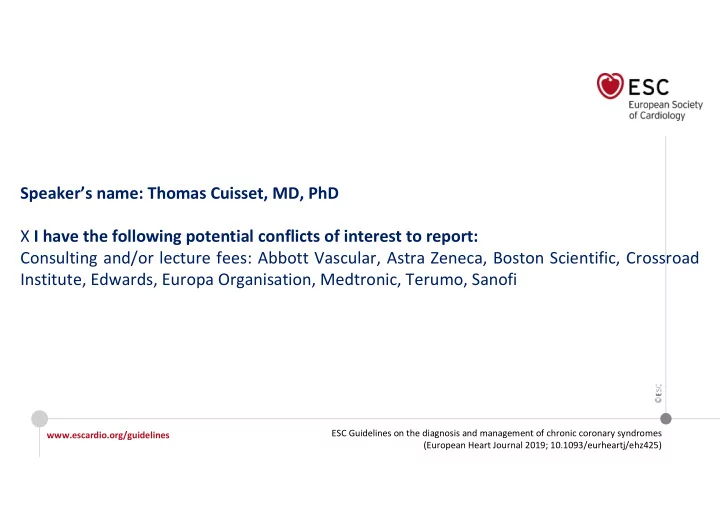

Speaker’s name: Thomas Cuisset, MD, PhD X I have the following potential conflicts of interest to report: Consulting and/or lecture fees: Abbott Vascular, Astra Zeneca, Boston Scientific, Crossroad Institute, Edwards, Europa Organisation, Medtronic, Terumo, Sanofi ESC Guidelines on the diagnosis and management of chronic coronary syndromes www.escardio.org/guidelines (European Heart Journal 2019; 10.1093/eurheartj/ehz425)
2019 ESC Guidelines on the diagnosis and management of chronic coronary syndromes « Messages clés » Thomas CUISSET CHU Timone, Marseille
2006 Stable Angina 2013 Stable Coronary artery disease 2019 Chronic coronary syndromes ESC Guidelines on the diagnosis and management of chronic coronary syndromes www.escardio.org/guidelines 3 (European Heart Journal 2019; 10.1093/eurheartj/ehz425)
One disease, two presentations Acute Coronary Syndrome Chronic coronary syndrome Planned patient Urgent admission Outpatient clinic Hospitalisation Non invasive testing Coronary angiography Risk = long term mortality Risk = short term mortality ESC Guidelines on the diagnosis and management of chronic coronary syndromes www.escardio.org/guidelines (European Heart Journal 2019; 10.1093/eurheartj/ehz425)
Diagnosis of CCS ESC Guidelines on the diagnosis and management of chronic coronary syndromes www.escardio.org/guidelines 5 (European Heart Journal 2019; 10.1093/eurheartj/ehz425)
Pre Test Probability (Age, sex symptom) Risk Factors, ECG, calcium score Clinical likehood of CAD Choice of diagnosis modality ESC Guidelines on the diagnosis and management of chronic coronary syndromes www.escardio.org/guidelines 6 (European Heart Journal 2019; 10.1093/eurheartj/ehz425)
Performance of Tests Test Clinical Likelihood of ICA -significant CAD A results 0% 50% 100% + Stress ECG - + Coronary CTA - + PET - Ranges of clinical likelihood for rule-in/out CAD + Stress CMR - Stress + - Echocardiography 85% + SPECT - Clinical Likelihood range where test can rule-in CAD (Post-test 85% 15% probability will rise above 85%) Clinical Likelihood range where test can rule-out CAD (Post-test probability will drop below 15%) ESC Guidelines on the diagnosis and management of chronic coronary syndromes www.escardio.org/guidelines 7 (European Heart Journal 2019; 10.1093/eurheartj/ehz425)
Choice of test for each patient Offer diagnostic testing testing mandated Coronary CTA f No diagnostic Invasive Choice of test based on clinical angiography likelihood, patient (with iwFR/FFR) characteristics and preference, e Testing for ischaemia availability, as well as local expertise d (imaging testing preferred) Very low Very high Clinical likelihood of obstructive CAD ESC Guidelines on the diagnosis and management of chronic coronary syndromes www.escardio.org/guidelines 8 (European Heart Journal 2019; 10.1093/eurheartj/ehz425)
Management of Chronic coronary syndrome Management of CAD Management of Symptom ‘Event prevention’ ‘Angina’ Prevention Anti-ischemic drug Life style Revascularisation Medications
Anti-ischemic drugs BB and CCB as first-line tailored to patient Long acting Nitrates as second line Others 10
Antithrombotic Strategy
DAPT for CCS When to do « more » ? When to do « less »? Standard No Antiplatelet drug if OAC indication ASA lifelong (IA) Optimized antithrombotic strategy ASA + Second Drug OAC + APLT drug in selected pt (IIb) High Risk patient (IIa) Or Clopidogrel Intermediate risk (IIb) If ASA intolerance (Ia) If prior PAD / Stroke (IIb)
DAPT after DES for CCS When to do « more » ? When to do « less »? Standard post PCI Early Potent P2Y12 blockers Ticagrelor or Prasugrel (IIb) Shorter duration ASA + Clopidogrel (IA) In High risk patients / PCI 3 Mo in HBR patients (IIa) Followed by de-escalation Duration = 6 Mo (IA) Longer duration 1 Mo in very HBR patients (IIb) > 6 Mo in High risk patients (IIa)
DAPT after DES for CCS with OAC When to do « more » ? When to do « less »? Standard post PCI High ischemic risk High Bleeding risk Triple therapy Longer triple therapy up to 6 Mo (IIa) Shorter Triple therapy (IIa) Full dose NOAC (I) ASA + Clopidogrel (I) Dual therapy Reduced Dose of NOAC (IIa) OAC + Tica / Prasu (IIb) 1 Month (I) Dabigatran, Rivaroxaban
Lipid-lowering drugs High Dose Statin / New target Add Ezetimibe if needed Consider PCSK9i if needed in High-risk Pt 15
Poor Secondary Event Prevention Atheroscerosis CAD Atherothrombotic events ACS / Arrythmias / Sudden Death Years
Good Secondary Event Prevention Atheroscerosis CAD Atherothrombotic events ACS / Arrythmias / Sudden Death Years
Revascularisation in CCS No Major change from earlier guidelines Revascularisation based on symptom / ischemia Value of FFR if stenosis < 90% and No ischemia No Major change after ISCHEMIA trial ? 18
Messages clés New title = Chronic coronary syndrome Screening: more CT / Less stress ECG / based on PTP Anti-ischemic drugs: BB and CCB / Nitrates as second line Event prevention Life style recommendations Optimized antithrombotic strategy in high-risk patients Optimized lipid-lowering therapy in high-risk patients Revascularisation for symptom +/- prognosis in high-risk pt Follow-up yearly …. And … 19
Optimized event prevention in high risk patient Optimized Antithrombotic strategy (IIaA recommendation) Ticagrelor 60 mg (PEGASUS): No reimbursement Rivaroxaban 2,5 mg (COMPASS): No reimbursement Optimized lipid-lowering therapy (IA recommendation) AntiPCSK9 = class IA in high-risk patient (FOURRIER, ODYSSEY): ASMR 5 How to apply guidelines with local constraint ?
www.escardio.org/guidelines Full Text ESC Pocket Guidelines App and much more… ESC Guidelines on the diagnosis and management of chronic coronary syndromes www.escardio.org/guidelines 21 (European Heart Journal 2019; 10.1093/eurheartj/ehz425)
Recommend
More recommend